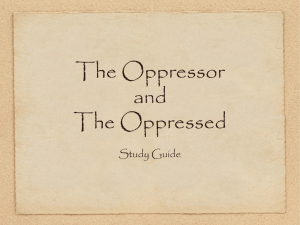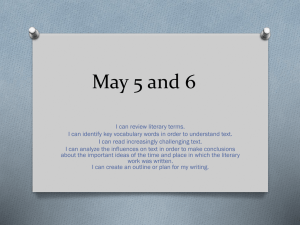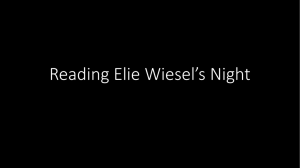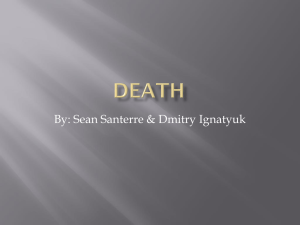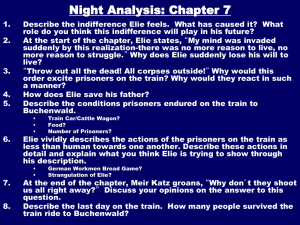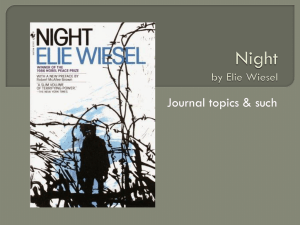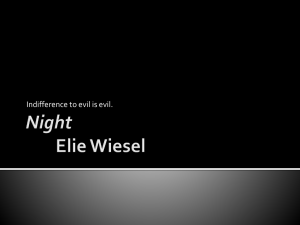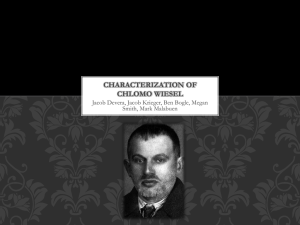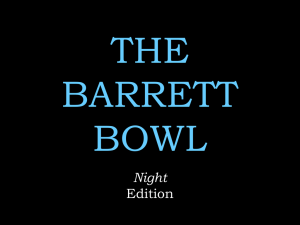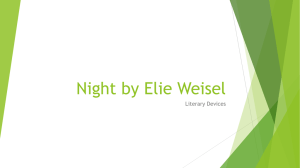NIGHT Study Guide - Warren County Schools
advertisement
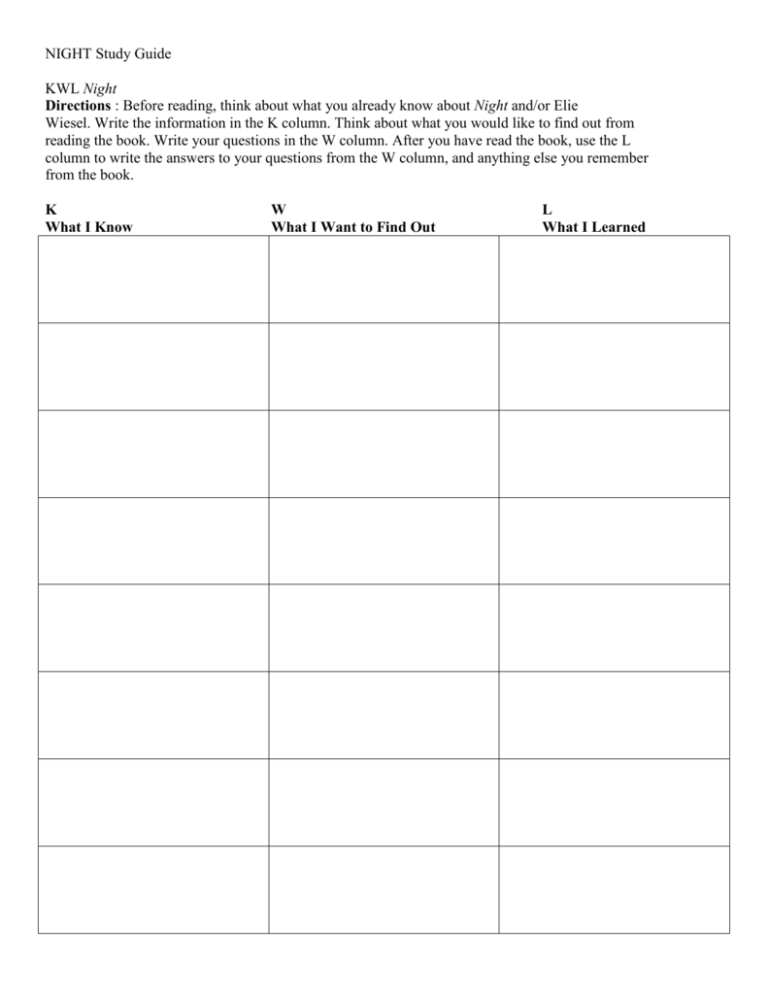
NIGHT Study Guide KWL Night Directions : Before reading, think about what you already know about Night and/or Elie Wiesel. Write the information in the K column. Think about what you would like to find out from reading the book. Write your questions in the W column. After you have read the book, use the L column to write the answers to your questions from the W column, and anything else you remember from the book. K What I Know W What I Want to Find Out L What I Learned SKETCHBOOK-JOURNAL You will be keeping a sketchbook. A sketchbook- journal is a combination of sketches about and written responses to the story. You are required to make an entry for each chapter in the novel. You can sketch memorable scenes from the chapters, or paste in magazine pictures that remind you of the events in the chapter. Include an explanation for each entry you make. The divisions are listed below – there are 9. You will be keeping a journal along with your sketchbook. You will be required to make an entry for each chapter in the novel. Again, there are 9. First, decide on the format for your sketchbook-journal. Spend some time decorating your cover and setting up the book. Make sure to include the title of each chapter and the page numbers in your copy of the book. Also date each entry. Even if you do not consider yourself a good artist, try to make some sketches. Use colors that remind you of the mood of the story. You can also take photographs and put them in the sketchbook-journal. Express a Personal Opinion The written entries should focus on your response to the literature, and should not merely be chapter summaries. They should include comments about your thoughts and feelings while reading, any questions you have, and predictions about the next chapter. Write at least one page for each of the 9 entries – 1 for each of the 9 sections. There are additional journal entries below that are SEPARATE from these 9. Here are some suggestions for the types of entries you may want to make. Check Your Understanding Explain how the story is making sense to you. Give examples and note page numbers. Establish the setting, mood, point of view, and character relationships. Discuss the stated themes. Make Inferences Explain your thoughts about the feelings and motives of the characters. Discuss the implied themes. Make and Revise Predictions At the end of each chapter, make a prediction about what you think will happen next. After you read, go back and check your predictions. Tell if you had to revise them, and why. Ask Questions Ask questions about scenes or events that are confusing. Record the answers if you discuss the questions in class, or later find the answer in the novel. Give Your Opinion Give your opinion about the literary quality of the work. Discuss the author's style, use of language, and use of literary devices. Tell why you do nor do not like the story. Tell how you feel while reading the chapters. Compare the book with others you have read. Make Connections Think about ways the characters and events relate to your own life and experiences. Put yourself in the character's place and discuss how you would think or feel in that situation. Try this from the point of view of the main character and a few of the minor ones. Make Recommendations Tell what you think the characters should do or say. Tell how you would end the story, or what you think might happen next. JOURNAL PROMPTS 1. Make a time line of World War II. 2. Research the country of Transylvania. Include its location on a map of prewar Europe. 3. Name the Allies and Axis countries and their leaders. Summarize the political policies and philosophies of each. 4. Identify Adolph Hitler and his role in the Third Reich. 5. Trace the persecution of the Jewish people in Europe. 6. Research the Jewish faith. Include major beliefs and holy days. 7. Explain the beliefs and practices of the Hasidic Jews. Compare these to the beliefs and practices of the Reform Jews. 8. Trace the origin and development of the Jewish nation. 9. Briefly explain the teachings of the Talmud, the Zohar and the cabbala. 10. Obtain information on the Holocaust from the Holocaust Museum in Washington, DC, or another source. 11. Describe any one of the concentration camps. Include a map with its location. 48 12. Describe the Occupation. Include the events that led up to it. 13. Describe the countries that made up pre-war Europe. Include the racial make-up of each. Draw a map to show the location of each country. 14. Discuss the involvement of the United States in World War II. 15. Summarize the events of World War I and explain how they led to World War II. 16. Explain the roles of the SS and the Gestapo. 17. Explain the significance of the Nobel Peace Prize. 18. Read and report on Elie Wiesel's continuing work for peace and human rights. 19. Explain how and where the surviving Jewish people resettled after the war. SHORT ANSWER QUESTIONS BY SECTION Section 1, pages 1-20 1. Describe Moshe the Beadle. 2. Describe Elie Wiesel's father. What was his occupation? 3. Why was Moshe the Beadle important to Elie Wiesel? 4. Summarize the story Moshe the Beadle told on his return from being deported. Why did he say he had returned to Sighet? 5. What was the public reaction to Moshe's story? 6. What was the setting and the year for the first section of the book? What was the world condition at the time? 7. Describe, in order, the events that happened from the last day of Passover until Pentecost. 8. How did Wiesel say he felt about the Hungarian police? 9. Who was Martha? What happened when she visited the Wiesel family in the ghetto? Sections 2, 3, pages 21-43 1. To what did Wiesel compare the world? 2. What did Madame Schächter see in her vision? 3. How did the other people in the car react to Madame Schächter? 4. Where did the train stop? 5. What did the Jews in the train car discover when they looked out the window? 6. When did Wiesel say the travelers left their illusions behind? 7. Which notorious SS officer did they meet at Auschwitz? 8. What was Elie's main thought as the men and women were being herded from the train? 9. What prayer were the people saying? Why was it unusual? 10. What did Elie do when the gypsy struck his father? Why? What was his father's response? 11. How long were Elie and his father at Auschwitz? Where did they go after that? Section 4, pages 45-62 1. Describe Elie's encounter with the dentist. 2. What did Elie Wiesel do when Idek hit his father? What was he thinking? 3. Who took Elie's gold tooth? Why did Elie give it up? 4. What were the only things in which Elie took an interest? 5. How did Elie describe the men after the air raid? 6. What happened to the young man from Warsaw? Why? 7. How did Elie say the soup tasted the night the pipel (young servant boy) was hanged? Section 5, pages 63-80 1. What did the men do on the eve of Rosh Hashana? 2. How did Elie feel while the others were praying? 3. What was Elie's decision about fasting on Yom Kippur? Why did he make that decision? 4. What was Elie's "inheritance" from his father? Why was his father giving it to him? 5. Did the men remember to say the Kaddish for Akiba Drumer? 6. What did Elie dream of when he dreamed of a better world? 7. What happened to the patients who stayed in the hospital instead of being evacuated? 8. What was the last thing the head of the block ordered the men to do before they evacuated? Why? 9. What was the weather like during the evacuation? Sections 6, 7, 8, 9, pages 81-109 1. While running, an idea began to fascinate Elie. What was the idea? What kept him from carrying out his idea? 2. What did Elie realize about Rabbi Eliahou and his son? 3. What was the name of the camp to which the men walked? 4. Describe Elie's meeting with Juliek. 5. How long were they at Gleiwitz? Where did they go next? 6. Who was Meir Katz? What happened to him? 7. How many men started out in the train? How many were left when they arrived at Buchenwald? 8. What happened to Mr. Wiesel, Elie's father? 9. What was Elie's only desire? 10. What happened on April 10, 1945? SHORT ANSWER QUESTIONS BY TYPE Interpretation 1. From what point of view is the story written? How does this affect our understanding of the story? 2. Why didn't the townspeople listen to Moshe the Beadle? 3. Describe Elie's relationship with Moshe the Beadle. 4. Why did the young girl at Buna risk her safety to speak to Elie in German? 5. In Section 4, Wiesel described the hanging of one young man. Then he said his soup was excellent that evening. What did he mean? 6. In Section 4, Wiesel described the hanging of the pipel, the young servant boy. He said the soup tasted of corpses that night. What did he mean? 7. Describe and analyze Elie Wiesel's changing view of God throughout the book. 8. In Section 6, why did Mr. Wiesel smile? 9. Describe the relationship between Elie and his father while they were in the concentration camps. Compare and contrast this with their relationship before their imprisonment. 10. Why do you think Moshe the Beadle stayed in Singhet when the people would not listen to him? What does this say about his character? 11. Why do you think Mr. Wiesel refused to go with Martha when she offered a safe refuge? 12. Was Madame Schächter crazy, or was she able to predict what was going to happen to the Jews? 13. Why did the Jews hold onto their illusions for so long? 14. In Section 5, why did Elie and his father choose to be evacuated instead of staying in the hospital? Critical 15. How did Elie Wiesel change over the course of the book? Were these changes for the better? 16. The author often used vivid language to describe a scene or event. Give an example of his use of vivid language that you found most effective. Tell why it was effective. 17. What was the overall mood of the story? Give examples to support your answer. 18. How would the story change if there were a different narrator? 19. Which character do you know the most about? Which character do you know the least about? 20. Were you able to predict the ending? What clues did the author give? 21. Discuss the author's use of language. Is it natural? Do people you know talk the way the characters did? 22. Does the mood of the story change? How does the author show this? 23. What words does the author use to create the atmosphere of the book? 24. Were the descriptions in the book effective? Give some examples. 25. Which senses did the descriptions cause you to use? Give examples of the descriptions using hearing, seeing, touching, smelling, taste. Personal Response 26. Did you enjoy reading Night? Why or why not? 27. Is Night a good title for the book? Why or why not? If not, what title would you suggest? 28. Did you have strong feelings while reading this book? If so, what did the author do to cause those feelings? If not, why not? 29. Will you read more of Elie Wiesel's books? Why or why not? 30. Did Elie Wiesel's experiences change the way you look at yourself? How? 31. Have you read any other stories similar to Night ? If so, tell about them. 32. Would you recommend this book to another student? Why or why not? 33. What makes Elie Wiesel a unique and different author? 34. What questions would you like to ask Elie Wiesel? 35. What was the saddest part of the story? 36. What do you remember most about the story? 37. What picture did the author leave in your mind? 38. What did the book make you think about? VOCABULARY Surname encumbered insignificant profoundly Deportees emigration treatise anecdotes Melancholy constraint provisions hermetically Pestilential notorious devoid monocle Lucidity convalescent blandishments convoy Frenzy torment thrash latter Raucous sabotage lamentation void Emaciated elapsed feeble evacuation Relentlessly deprive bereaved apathy Livid dregs vitality tether Contagion plaintive recesses CONFLICT CHART Directions: Use the chart below to record examples of the different types of conflict you read about in Night. CONFLICT CHARACTER VS. NATURE CHARACTER VS. SELF CHARACTER VS. SOCIETY CHARACTER VS. CHARACTER EXAMPLE and PAGES CHANGE in Elie FIGURES OF SPEECH Figures of speech are literary devices that give the writer a non-literal way to describe images and events. They are comparisons that help the reader create a mental image of a character or a situation. HYPERBOLE Extreme exaggeration used to describe a person or thing. For example: She has as many pairs of earrings as there are stars in the sky. IRONY The use of words to express something different from and often opposite to their literal meaning. For example: Yeah, being a kid is one laugh after another. METAPHOR A comparison without the words like or as. For example: The cat is a bag of bones. METONYMY A figure of speech in which one word or phrase is substituted for another with which it is closely associated, as in the use of Washington for the United States government or of the sword for military power. ONOMATOPOEIA The use of words such as buzz or splash that imitate the sounds associated with the objects or actions they refer to. PARADOX A seemingly self-contradictory statement that has some truth to it. For example: sitting may be more exhausting than standing PERSONIFICATION Attributing human characteristics to inanimate objects, animals, or ideas, as in the wind howled. SIMILE A comparison using the words like or as. For example: I felt as light as a feather. FIGURES OF SPEECH Figures of speech are literary devices that give the writer a non-literal way to describe images and events. The main types of figures of speech are hyperbole, irony, metaphor, metonymy, onomatopoeia, paradox, personification, and simile. Use the following chart to record examples of figures of speech used in Night. A sample has been done for you. Simile physically he was as awkward as a clown page 43 He was clumsy and not graceful. Figure of Speech Example from Novel page # Literal Meaning
